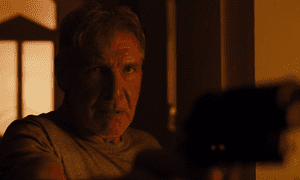Peter Bradshaw / The Guardian
With this visually staggering film, director Denis Villeneuve brings us to a kind of Ozymandias moment. It just has to be experienced on the biggest screen possible. Blade Runner 2049 is a narcotic spectacle of eerie and pitiless vastness, by turns satirical, tragic and romantic.
This is the sequel to the 1982 sci-fi classic, directed by Ridley Scott and based on Philip K Dick’s novel Do Androids Dream Of Electric Sheep?, starring Harrison Ford as a “blade runner”, a futureworld cop whose job is to track down and kill disobedient almost-human androids known as replicants. The 2017 follow-up simply couldn’t be any more of a triumph: a stunning enlargement and improvement.
Its mind-boggling, cortex-wobbling, craniofacial-splintering images are there to trigger awe or even a kind of ecstatic despair at the idea of a post-human future, and what it means to imagine the wreck of our current form of homo sapiens. Evolution has not finished yet, any more than it was finished 100,000 years ago. As so often in literature and cinema, we are reminded that science fiction is there to tackle big ideas, and makes realist genres look flimsy and parochial. This film delivers pure hallucinatory craziness that leaves you hyperventilating.
Blade Runner 2049 is co-scripted by the original screenwriter, Hampton Fancher, and riffs on the first film. There are poignant theme-variations on memory and crying in the rain and a cityscape full of signs in different languages (Russian, Japanese, Hindi, Korean), ghostly VR advertising avatars and flashing corporate logos, playfully including the obsolete PanAm.
There is something so sinuous and manoeuvrable about the drama, and its CGI rendering is like nothing I’ve ever seen
It alludes to films the first Blade Runner helped inspire, such as Cameron’s The Terminator, Spielberg’s AI Artificial Intelligence, Nolan’s The Dark Knight, Andrew Stanton’s WALL-E and Spike Jonze’s Her. The references reach further back also, to the Kubrickian hotel-bar and spaceship, and to the desolate final moments of Planet of the Apes. You could call that ancestor-worship, were it not that the franchise already deserves its own ancestor status. In fact, the sequel slightly de-emphasises the first film’s intimate, downbeat noir qualities in favour of something more gigantic and monolithic, preserving Ridley Scott’s massively controlled andante tempo. Yet there is something so sinuous and manoeuvrable about the drama, and its CGI rendering is like nothing I’ve ever seen.
The setting is Los Angeles, 30 years on from the first film’s 2019 setting. The corporation that once manufactured the replicants, whose spartacist uprising was the original theme, has been bought out by an agribusiness empire owned by one Niander Wallace (Jared Leto), a grotesque figure brooding on how to create replicant-workers on a scale sufficient for his imperial plans. Ryan Gosling plays LAPD officer K, a limited-lifespan replicant whose task is to track down and destroy those first-gen models who can live as long as humans, and are still illegally hiding out. K has a gorgeous virtual-reality live-in girlfriend, quibblingly named Joi (Ana De Armas), with whom he believes himself to be in love, though he understands that both she and he are constructed artefacts.
After making a sensational discovery, K embarks on a dangerous mission, and both his LAPD boss Lieutenant Joshi (Robin Wright) and Wallace himself are very interested in what he might discover. Wallace despatches his deadpan assistant, named Luv and superbly played by Sylvia Hoeks, with an utterly unnerving habit of crying when her face appears to show no human emotion at all. It is all leading to a mysterious, Freudian encounter with Rick Deckard himself, the outsider cop from the first film, played with haggard misanthropy by Harrison Ford.

The sheer electric strangeness of everything that happens is what registers. Every time K finishes a mission, he is taken to an interrogation module to be … what? Debriefed? Decompressed? Deconstructed? He is subjected to a fierce kind of call-and-response dialogue in which he has to respond to key words such as “cells” to see if his humanoid/android identity balance is out of whack. It is utterly bizarre, and yet entirely compelling, and persuasively normal in this alienated universe. K’s aerial journeys in his battered, government-issue squadcar-miniplane are similarly enthralling, and a scene in which he is brought down over a gigantic rubbish dump in San Diego by a low-tech harpoon gun is one of the most exciting action-movie scenes imaginable.
The production design by Dennis Gasner and cinematography by Roger Deakins are both delectable, and the largely electronic musical score by Benjamin Wallfisch and Hans Zimmer provides a kind of aural neon: gaunt, harsh, angular, like the noise of machinery. It’s an incredible lucid dream. Weirdly, I had forgotten about one of the little-discussed pleasures of the big screen: the simple effect of dialogue, echoing in a movie theatre. This film’s scale is extraordinary. It places the acid tab of cinema-pleasure on your tongue.
